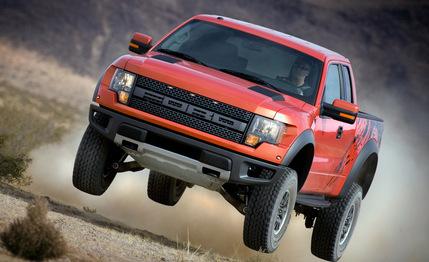
 First Drive Review
First Drive Review
With flamboyant, seven-foot-wide bodywork plastered with “digital mud”; an industry-first, long-travel suspension; and a résumé that includes a third-in-class finish at the Baja 1000, Ford’s 2010 F-150 SVT Raptor is about as subtle as the feeling one gets sitting on a cactus. Naked. That a street-legal, 6000-pound pickup designed to traverse the open desert at 100 mph even made it past Dearborn’s byzantine and conservative product-review board is a miracle in itself. But after a grueling and secretive development period—during which Ford’s marketing department was heard talking of driving the truck “right up Toyota’s ass”—it did. And we can confirm after some thrilling seat time near California’s Anza-Borrego Desert State Park that the Raptor is one of the most formidable off-road production vehicles ever built.
No Comparisons
Ever-greater performance vehicles come out all the time. And with each iteration, we usually can sum up their placement on our automotive totem pole by referencing how much quicker they are than this, or how they grip the road better than that. But there are no formal benchmarks for the Raptor; this is way beyond Rovers, Hummers, and Unimogs.
A track widened seven inches over that of a normal F-150, with reinforced underpinnings suspended by unique front coil springs and rear leaf springs, is what gives the Raptor its impressive front and rear suspension articulation of 11.2 and 12.1 inches, respectively. Cool details abound the chassis, too, particularly the “SVT” stampings on the aluminum control arms. But the magic lies in the massive three-stage, internal-bypass shocks from Fox Racing. Commonly found in purpose-built racing trucks and pre-runners, these high-end units compress progressively, with a firm initial stage for good body control and softer second and third stages that allow maximum wheel travel at high speeds off-road.
On the highway, the Raptor feels much like the softer-sprung, four-wheel-drive F-150 on which it’s based, with the shocks keeping the body from flopping about during transitions. Get the Raptor in its element, though, and it gobbles up rough terrain like a Ferrari tackling a chicane. Traversing a winding desert wash with large rocks, undulations, and two-foot-tall whoops, we frequently reached highway speeds with little drama. Ford’s more experienced pilots regularly hit the truck’s 100-mph speed governor over the same section. That the company’s own press photos show the truck launching all four wheels several feet in the air speaks to what the Raptor was built for. We of course had to try, more than once, and almost succeeded—albeit by accident—in clearing a two-lane fire road at what felt like 50 mph. The landing was a little rough, but the truck rarely bottomed out during our drive, and we never wished for a neck brace or kidney belt.
More Than Just Fancy Shocks
If the Raptor’s added width and trick dampers are its foundation, its myriad electronic and drivetrain upgrades make up the total package. At each corner are beefed-up disc brakes (13.8 inches in front, 13.7 in the rear) surrounded by 17-inch alloy wheels and SVT-specific, 35-inch BFGoodrich all-terrain tires. Differentials with 4.10:1 gears help turn the hefty rolling stock, and the rear axle sports an electronic locker that can spool both wheels together for maximum traction. Ford’s two-stage electronic stability-control system sports a special off-road mode that raises the threshold for yaw and anti-lock-brake intervention, sharpens throttle response, remaps the six-speed automatic to hold gears longer, and allows the locking diff to stay activated up to the vehicle’s top speed. A new hill-descent-control system is included and worked great to limit our speed while crawling down steep slopes lined with jagged rocks and deep holes.